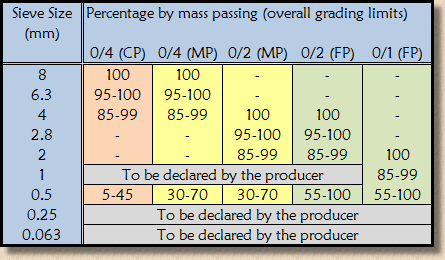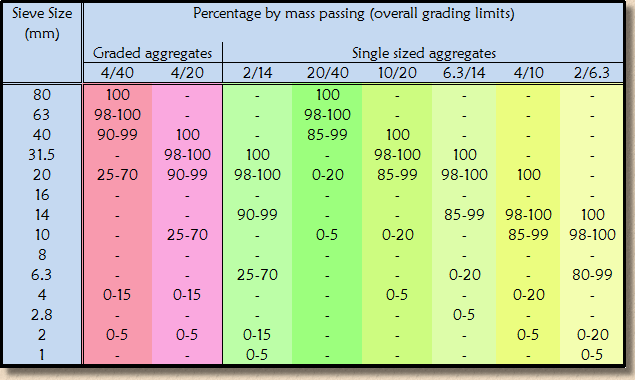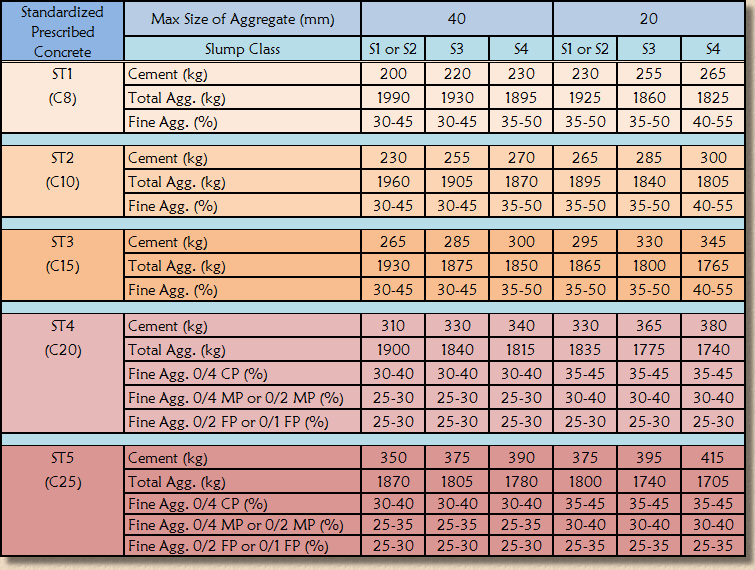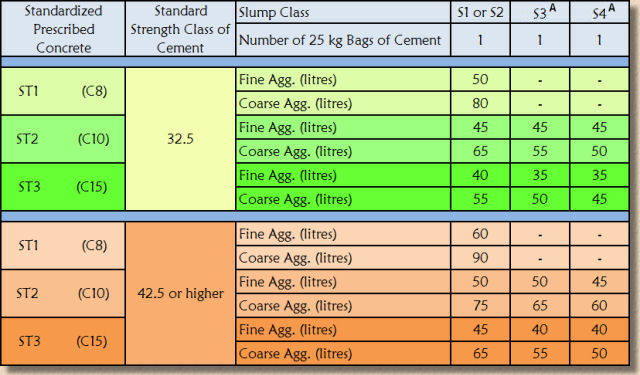Introduction:
Specification for Standardised Prescribed Concretes
This page, co-written with Malcolm Bruce, gives the technical information on the requirements for aggregates used in the preparation of concrete taken from:
... and the recommendations for Standardised Prescribed Concretes taken from...
...the latter being the European standard for concrete.
Standardised prescribed concretes are used on housing projects and similar construction jobs, such as paving and drainage, where concrete is batched on-site or obtained from a local ready mixed concrete company.
Note that, when buying-in ready mixed standardised prescribed concretes*, the supplier does not need to have third-party product conformity certification via schemes such as QSRMC or BSI Kitemark, but such accreditation is always to be recommended.
While these standardised prescribed concretes are fairly basic mixes, they still have to be produced under strict production control procedures which seek to ensure the concrete produced will conform in all ways to the specified requirements.
Detailed guidance is given in BS EN 206
* Designated concretes (not to be confused with designed concretes) such as GEN's, RC's, FND's and PAV's, which represent a significant percentage of all ready mixed concrete produced, can only be supplied by companies that do have third-party product conformity certification – reference BS 8500-2 Clause 6.4.2
Definitions:
Aggregates are classed as "fine" (think sand) and "coarse" (think gravel) and variable proportions of each are mixed with a quantity of cement and water to produce concrete.
The first section below gives overall grading limits for fine and coarse aggregates, while the second section gives batch quantities for standardised prescribed concretes. The last section gives an explanation of free water:cement ratio.
As an example, the approximate quantities of materials used to produce one cubic metre (1m³) of ST4 (C20) concrete at medium workability ( slump class S2 ) are:
- Cement (standard strength class 32.5) – 330 kg
- Fine aggregate (sand) – 735 kg
- Coarse aggregate (4/20 mm gravel) – 1100 kg
- Water – 180 kg (180 litres)
Fine Aggregates
The coarseness and fineness of fine aggregates are denoted by the letter C for coarse grading, M for medium grading and F for fine grading. Just to complicate matters, the letter P is added after C, M or F to denote the percentage of the aggregate passing through a 0.5 mm sieve.
So, in Table 1 below, looking at coarse aggregate in the first column, the percentage passing (P) through the 0.5mm sieve is shown as 5-45, so not more than 45% of the tested aggregate will clear the sieve.

Fine aggregate sizes are further denoted by the mesh size of the lower and upper sieves between which most of the particle size distribution lies, e.g. 0/4 mm, 0/2 mm etc., which indicates that most of the particles will be 0 to 4mm or 0 to 2mm in size.

Coarse Aggregates
Coarse aggregate sizes are denoted by the mesh size of the lower and upper sieves between which most of the particle distribution lies, e.g. 4/10 mm, 10/20 mm, 2/6.3 mm etc.

Mix Proportions for Standardised Prescribed Concretes
The mix proportions given in Table 4 below for standardised prescribed concretes will produce approximately one cubic metre (1m³) of fully compacted concrete.
In effect, this is a recipe for how to make concrete of a particular strength, with a particular slump, using specific aggregates. As can be seen, coarse aggregate can be 20mm or 40mm maximum size, and there are four slump classes (S1 - S4). Once this has been decided, it's a matter of determining the strength required (ST1 to ST5) and then reading across the table to identify the required cement content, the total aggregate content, and the proportion of that aggregate which should be a particular grade of fine aggregate. Clear as concrete, eh?
The values given are based on the use of standard strength class 32.5 cement which will normally produce a concrete having characteristic strengths ranging between 8 and 25 N/mm2 at 28 days. Aggregate quantities are based on them being in a condition referred to as "saturated surface dry", which in simpler terms means damp, but not sopping wet, so allowance must be made for moisture content - i.e. add less water for very wet aggregates, more water for aggregates which are quite dry.
It is important to note that:
- All materials must be accurately weighed spacer (although ST1, ST2 and ST3 may also be batched by volume)
- Permitted cement types are:
- CEM I - (Ordinary Portland Cement)
- CEM IIA-L or LL - (Portland/limestone cement)
- CEM IIA-S- (Portland/ggbs cement)
- CEM IIA-V - (Portland/fly-ash cement)
- CEM IIB-S - (Portland/ggbs cement)
- CEM IIB-V - (Portland/fly-ash cement)
- CEM IIIA - (Portland/ggbs cement)
- When batching by weight, the cement contents may be reduced by 10 % if the standard strength class of the cement is greater than 32.5, i.e. 42.5 or higher
- Coarse, fine and all-in aggregates must comply with BS EN 12620 – Aggregates for concrete
- All-in aggregate (also known as ballast) is only permitted for ST1, ST2 and ST3
- Recycled aggregates must not be used
- Admixtures are permitted with the exception of an air entraining admixture (AEA)
Batching by Weight

Batching by Volume
As mentioned previously, concrete of strength classes ST1, ST2 or ST3 can be batched by volume. This is often useful for when working on a small site where a relatively small quantity of concrete is required, and the possibility of having fancy weighing equipment is pretty much non-existent.
Table 5 below gives recipes to produce a given strength of concrete, with a particular slump, all using just one 25kg bag of cement. The table is split into two halves, with the upper section being the recipes for some of the 'general purpose' cements (32.5) and the lower half considering the use of higher strength cement (42.5 or above) which is becoming increasingly popular. Packaging should state the strength of the cement contained within, so check this before mixing the concrete.
As an example, if we were building a step to a front door and needed a barrowful or two of ST1 concrete to act as a footing for the step risers, and we had a bag of 42.5 cement, looking at the lower section of Table 5, we can see that for ST1 concrete, we'd need to add 60 litres of fine aggregate (sand) and 90 litres of coarse aggregate (gravel). We can use a bucket to measure the volume of aggregate - a typical builder's bucket will hold 10 litres but check the graduations on the inside to be certain.

A - For slump classes S3 and S4, use fine aggregates MP and CP only.
Free water-cement ratio
Free water:cement ratio is one means of assessing the potential durability of concrete. Very simply, the lower the water:cement ratio, the more durable the concrete. This is why, when having ready-mix delivered to site, if the driver is asked to 'wet it up' by adding more water, someone has to sign a docket which more-or-less indemnifies the concrete supplier against any claim for weaker-than-expected concrete.
The free water:cement ratio is calculated by dividing the mass of free water contained in the concrete by the mass of cement. Free water is essentially the volume of water added to the mix but excluding that absorbed by the aggregate prior to mixing. Values for the free water:cement ratio range typically between 0.35 and 0.70.
As the specific density of water is 1.00, 1 litre per cubic metre can be expressed as 1 kg per cubic metre therefore if the mass of free water is 170 litres per cubic metre and the mass of cement is 340 kg per cubic metre, the free water:cement ratio is....
170 ÷ 340 = 0.50
The quantity of water contained in a cubic metre of concrete varies with a number of factors such as slump class , the size, type and grading of the aggregates , the cement content, and the type of any admixture added and its dosage rate.
The following table gives a rough guide showing the number of litres of water per cubic metre based on a cement content of about 300 kg per cubic metre....

The responsibility for specifying the water:cement ratio lies clearly with the designer as he or she knows the environment in which the concrete is being placed, the intended design life of the structure, the size and shape of the unit being cast and the depth of cover to any reinforcement .
The specified water:cement ratio is, in most cases, accompanied by a specified minimum cement content. Detailed guidance is given in various tables in BS 8500 The responsibility for conforming to the specified requirements lies with the producer of the concrete.
